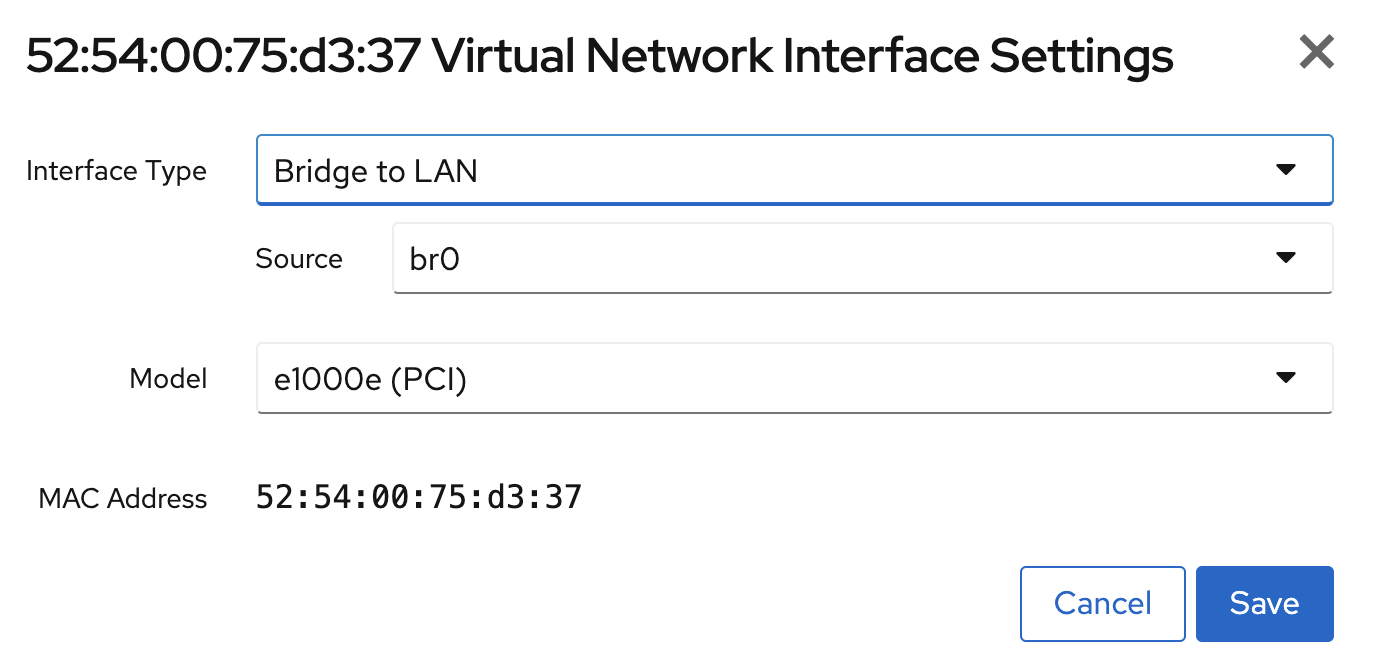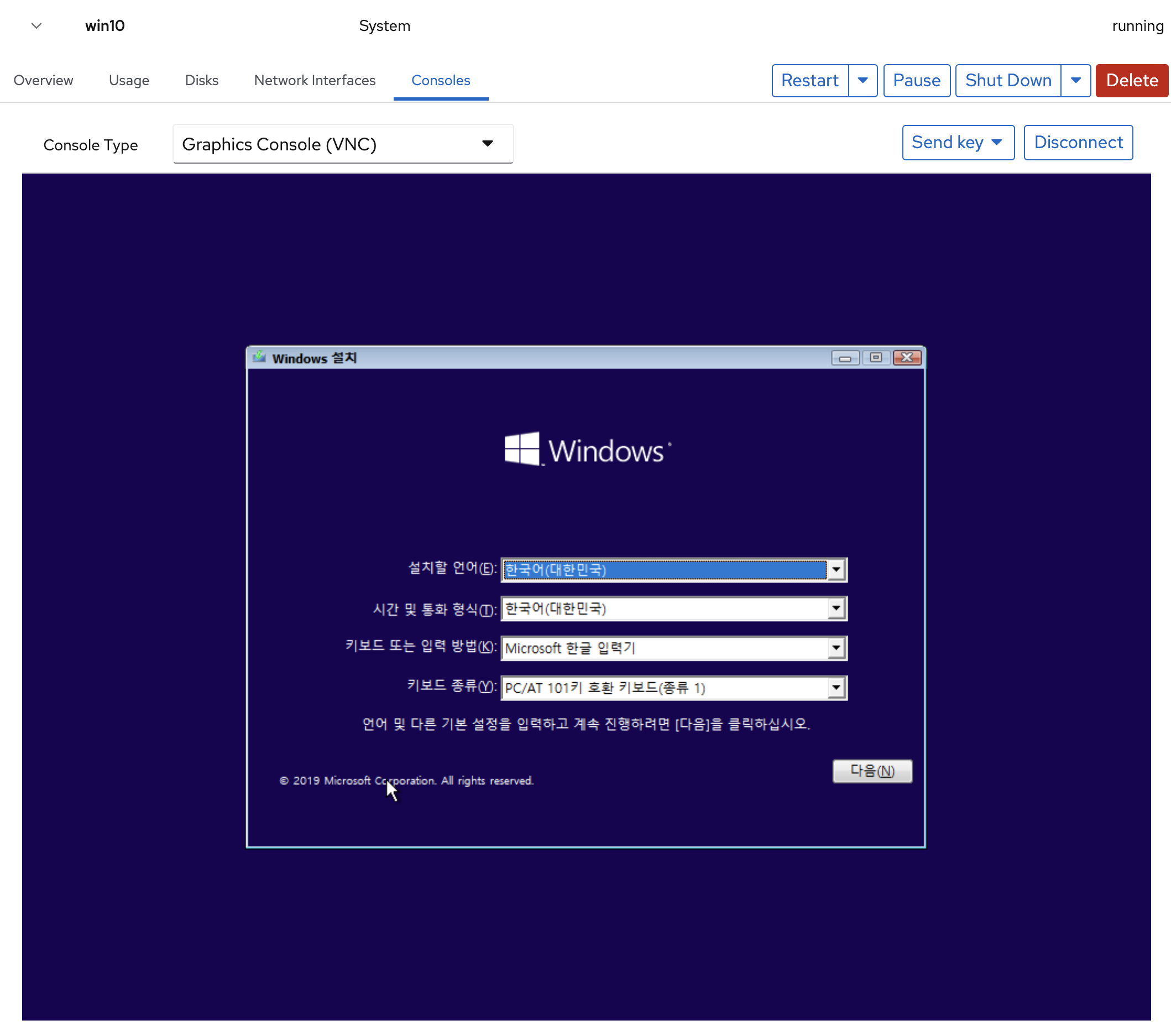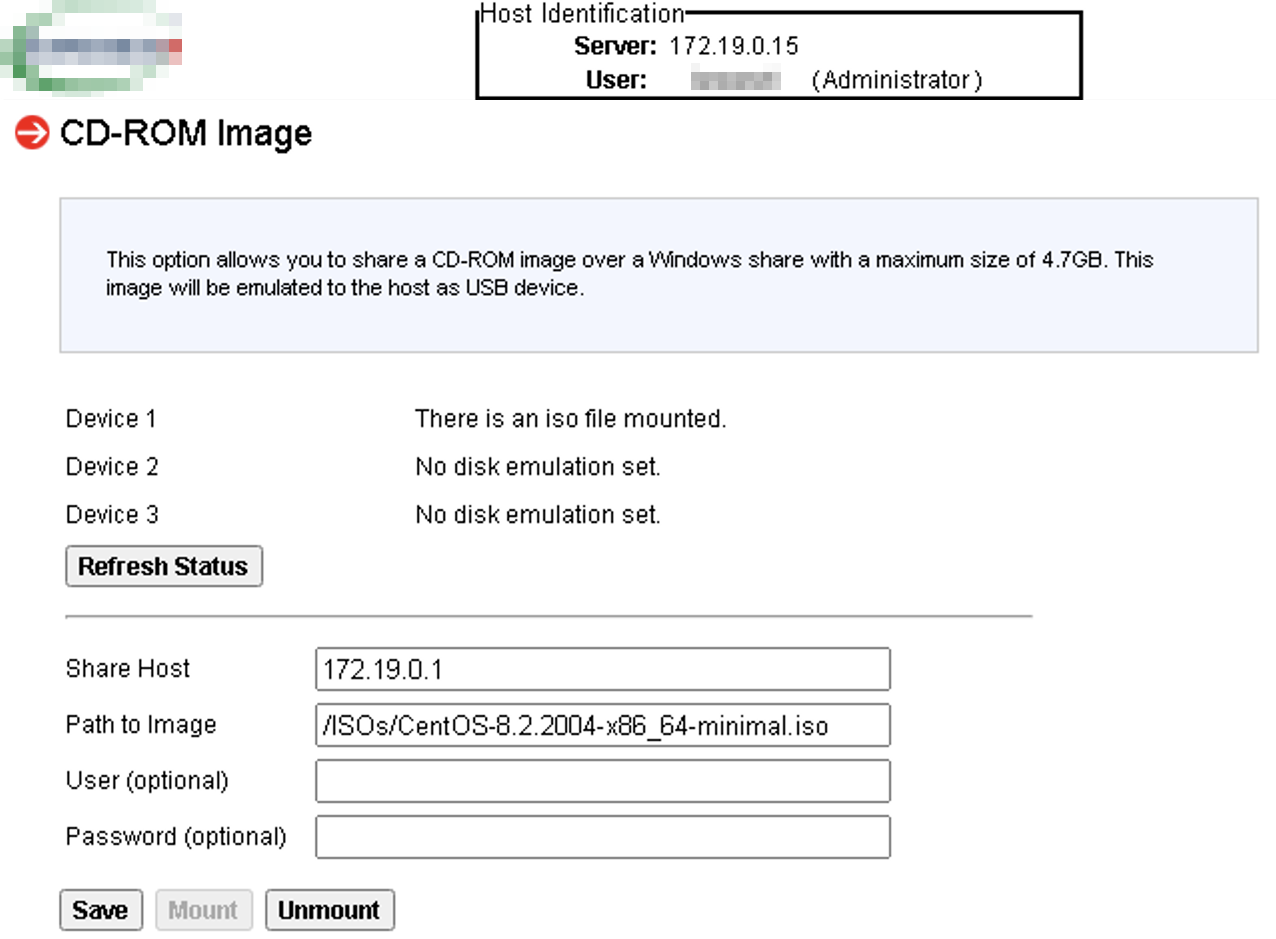Architectures
INTERNET
External |
eno1|
+------------+------------+
| |
| HOST |
| +----------+|
| | RDP-VM ||
| |172.19.0.3||
| +----------+|
+------------+------------+
br0(eno2)|172.19.0.1
Internal |
|
Servers (IPMI,iDRAC,iKVM..)
Install
sudo yum -y install dnsmasq cockpit-machines httpd sudo systemctl restart cockpit.socket sudo systemctl enable --now cockpit.socket sudo systemctl enable --now dnsmasq sudo systemctl enable --now httpd
Network Configs
Connect to Cockpit
Connect to Cockpit via https://<IP>:9090
Login as your root user
Create Bridge
Cockpit → Networking → Add Bridge
Change Name to 'br0' and add Ports(NICs) for the internal network.
Click br0 → Click IPv4 - Automatic (DHCP)
Click Manual → Insert internal information
NAT config (if needed)
Enable ip_forward
sudo vi /etc/sysctl.conf # Add the following line net.ipv4.ip_forward = 1 # Apply sysctl.conf without reboot sudo sysctl -p /etc/sysctl.conf
Add MASQUERADE rule
sudo -s INT=br0 EXT=eno1 firewall-cmd --permanent --zone=public --add-masquerade firewall-cmd --permanent --direct --add-rule ipv4 nat POSTROUTING 0 -o $EXT -j MASQUERADE firewall-cmd --permanent --direct --add-rule ipv4 filter FORWARD 0 -i $INT -o $EXT -j ACCEPT firewall-cmd --permanent --direct --add-rule ipv4 filter FORWARD 0 -i $EXT -o $INT -m state --state RELATED,ESTABLISHED -j ACCEPT firewall-cmd --reload
Port Forward (of Windows VM for Remote Desktop)
sudo firewall-cmd --permanent --zone=public --add-forward-port=port=<YOUR_RDP_PORT>:proto=tcp:toport=3389:toaddr=172.19.0.3 sudo firewall-cmd --permanent --add-port=<YOUR_RDP_PORT>/tcp sudo firewall-cmd --reload
Firewall Settings
sudo firewall-cmd --zone=public --add-service=cockpit sudo firewall-cmd --zone=public --add-service=dhcp sudo firewall-cmd --zone=public --add-service=dns sudo firewall-cmd --zone=public --add-service=samba sudo firewall-cmd --zone=public --add-service=http sudo firewall-cmd --permanent --add-port=<YOUR_SSH_PORT>/tcp sudo firewall-cmd --permanent --add-port=<YOUR_RDP_PORT>/tcp sudo firewall-cmd --reload
DHCP Sever Configs
nameserver 8.8.8.8 nameserver 134.75.30.1 nameserver 1.1.1.1
interface=br0 except-interface=lo bind-interfaces listen-address=127.0.0.1 listen-address=172.19.0.1 #domain-needed bogus-priv #no-resolv resolv-file=/etc/dnsmasq-resolv.conf #filterwin2k expand-hosts domain=kisti.kr local=/kisti.kr/ dhcp-option=option:netmask,255.255.255.0 dhcp-option=option:router,172.19.0.1 dhcp-option=option:dns-server,172.19.0.1,8.8.8.8 dhcp-option=option:ntp-server,141.223.182.106 # ntp.postech.ac.kr dhcp-range=172.19.0.2,172.19.0.253,5m dhcp-lease-max=252 dhcp-leasefile=/var/lib/dnsmasq/bmc.leases
Make bmc-hosts.conf with respect to asset number.
자산번호를 참고하여 bmc-hosts.conf 작성
It is good to write some comments on the asset after #
샾(#) 다음에 자산과 관련된 메모를 남기면 좋음
dhcp-host=52:54:00:3B:D9:A6,RDP-VM,172.19.0.3 # rdp dhcp-host=AC:1F:6B:F9:25:CD,2019001231-bmc,172.19.0.15 # 1G PS ; 2019. dhcp-host=AC:1F:6B:F9:31:63,2020000561-bmc,172.19.0.17 # 10G PS ; DS20A5S120010 dhcp-host=AC:1F:6B:F9:32:45,2020000562-bmc,172.19.0.19 # 10G PS ; DS20A5S120012
You can access the control (iDRAC, IPMI, ...) via asset number - https://<asset number>.kisti.kr
자산번호로 관리콘솔 (iDRAC, IPMI, ...)에 접속 가능함
sudo systemctl restart dnsmasq
Create Windows VM for Remote Management
Connect to Cockpit
Connect to Cockpit via https://<IP>:9090
Login as your root user
Enable Libvirt (if needed)
Create Virtual Machine
Put Win10 Pro ISO on /ISOs, then create VM
Check Network
add the following line in bmc-hosts.conf and restart dnsmasq
dhcp-host=52:54:00:75:d3:37,RDP-VM,172.19.0.3 # rdp
Modify Network (to bridge)
Install Windows on VM
It would be helpful to skip security questions on windows installation.
How to skip the security questions during the Windows 10 Setup
Config on VM
Do config for Remote Desktop
Install some programs you needed
Connect to VM via Remote Desktop
SAMBA Configs
Download ISO images, Change selinux context
sudo mkdir /ISOs chmod 777 /ISOs cd /ISOs wget http://ftp.kaist.ac.kr/CentOS/8.2.2004/isos/x86_64/CentOS-8.2.2004-x86_64-minimal.iso wget http://ftp.kaist.ac.kr/ubuntu-cd/20.10/ubuntu-20.10-desktop-amd64.iso wget http://ftp.kaist.ac.kr/ubuntu-cd/20.10/ubuntu-20.10-live-server-amd64.iso ... sudo semanage fcontext -a -t samba_share_t /ISOs
Change configs
[global] server min protocol = NT1 bind interfaces only = yes interfaces = lo br0 workgroup = WORKGROUP log level = 2 map to guest = Bad User log file = /var/log/samba/log.%m [ISOs] path = /ISOs public = yes browsable = yes read only = yes
Change configs
sudo systemctl status smb
Change configs
sudo systemctl status smb
Mount ISO image on BMC (iDRAC, IPMI, ...) | Check the logs on samba server to access the ISO file on via # tail -f /var/log/samba/log.172.19.0.15 ... [2020/11/04 13:39:45.950194, 2] ../../source3/smbd/open.c:1456(open_file) ...... opened file CentOS-8.2.2004-x86_64-minimal.iso read=Yes write=No (numopen=1) |
















